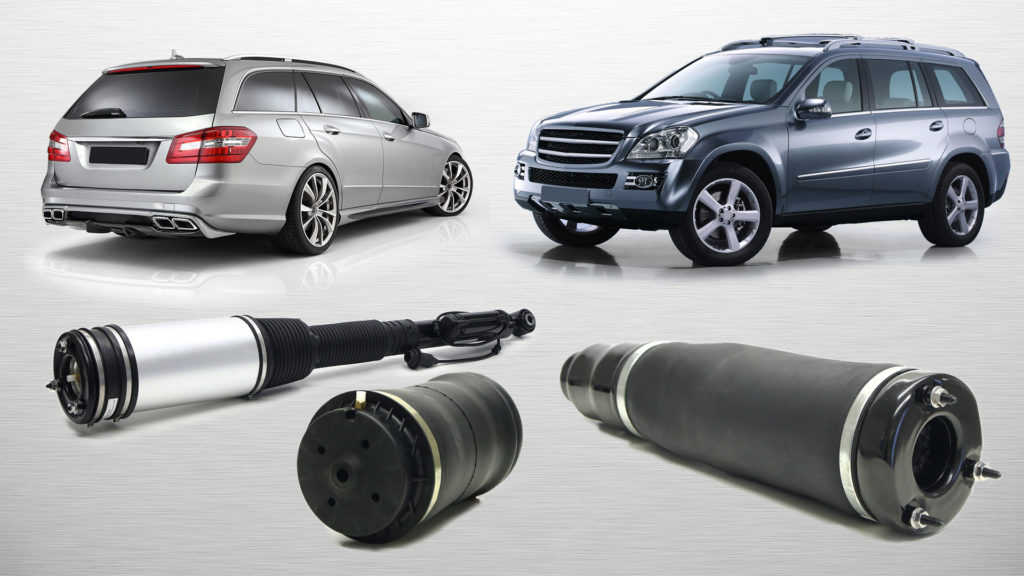
What is Airmatic Suspension?
The Mercedes Benz Airmatic suspension was first created by the company to tackle issues surrounding road conditions and to improve upon the companies previous suspension designs. Throughout the process, they have created the Airmatic system in order to provide drivers with smooth driving on high-speed motorways and one that is also adaptable for uneven rural road conditions.
The Airmatic suspension system has a built-in self-adjusting dynamical system to account for changes in road conditions. The dampening mechanics allow drivers to navigate to their destination in a famously smooth driving experience.
Airmatic and ADS
There are both soft and hard suspension formats that interchange, depending on the road conditions and speed of the vehicle. The Airmatic suspension applies soft suspension during high-speed, low-impact driving; whereas the Airmatic shocks initiate hard suspension in stretches of less-than-ideal road conditions. If you are driving through bumps on the road, the Airmatic suspension is designed to absorb the shock and ensure tyres maintain contact with the road.
These Airmatic air shocks also minimise the roll of the vehicle around curves, due to its ability to maintain a centre of balance as a result of Adaptive Damping System (ADS) in the shock absorbers. The ADS veers away from traditional steel springs, revolutionising the driving experience for Mercedes-Benz customers and they work congruently with the Airmatic system to allow for silky-smooth cruising for drivers.
Mercedes Range of Vehicles
In additions to this, Mercedes have managed to incorporate rebound adjustment compression to eliminate pulsations and sounds throughout your drive.
The Airmatic system was first developed and incorporated in the S Class of Mercedes-Benz cars and is now prevalent in a wide range of their models. Customers can now avail of the Airmatic suspension in E class, R class, CL class, S class, and even those very lucky Mercedes Maybach owners!
Vehicle Compatibility
If you want to see if your vehicle’s compatibility with our Airmatic air suspension range, please view our product listings or contact us directly.
We also have an article on some of the common Mercedes Benz Airmatic suspension problems and concerns, available here.
To view our Mercedes S Class air shocks that have Airmatic suspension, you can view them here. If you have any questions about our Mercedes S Class air suspension products, please do not hesitate to contact us: sales@carairsprings.com.
The Mercedes Benz Airmatic suspension was first created by the company to tackle issues surrounding road conditions and to improve upon the companies previous suspension designs. Throughout the process, they have created the Airmatic system in order to provide drivers with smooth driving on high-speed motorways and one that is also adaptable for uneven rural road conditions.
The Airmatic suspension system has a built-in self-adjusting dynamical system to account for changes in road conditions. The dampening mechanics allow drivers to navigate to their destination in a famously smooth driving experience.
Airmatic and ADS
There are both soft and hard suspension formats that interchange, depending on the road conditions and speed of the vehicle. The Airmatic suspension applies soft suspension during high-speed, low-impact driving; whereas the Airmatic shocks initiate hard suspension in stretches of less-than-ideal road conditions. If you are driving through bumps on the road, the Airmatic suspension is designed to absorb the shock and ensure tyres maintain contact with the road.
These Airmatic air shocks also minimise the roll of the vehicle around curves, due to its ability to maintain a centre of balance as a result of Adaptive Damping System (ADS) in the shock absorbers. The ADS veers away from traditional steel springs, revolutionising the driving experience for Mercedes-Benz customers and they work congruently with the Airmatic system to allow for silky-smooth cruising for drivers.
Mercedes Range of Vehicles
In additions to this, Mercedes have managed to incorporate rebound adjustment compression to eliminate pulsations and sounds throughout your drive.
The Airmatic system was first developed and incorporated in the S Class of Mercedes-Benz cars and is now prevalent in a wide range of their models. Customers can now avail of the Airmatic suspension in E class, R class, CL class, S class, and even those very lucky Mercedes Maybach owners!
